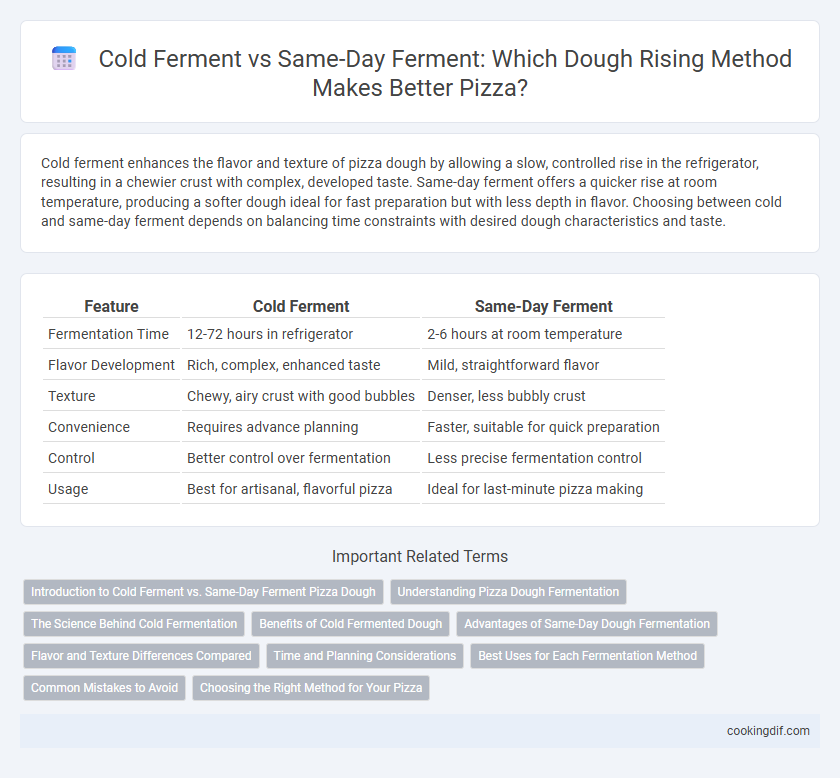Cold ferment enhances the flavor and texture of pizza dough by allowing a slow, controlled rise in the refrigerator, resulting in a chewier crust with complex, developed taste. Same-day ferment offers a quicker rise at room temperature, producing a softer dough ideal for fast preparation but with less depth in flavor. Choosing between cold and same-day ferment depends on balancing time constraints with desired dough characteristics and taste.
Table of Comparison
| Feature | Cold Ferment | Same-Day Ferment |
|---|---|---|
| Fermentation Time | 12-72 hours in refrigerator | 2-6 hours at room temperature |
| Flavor Development | Rich, complex, enhanced taste | Mild, straightforward flavor |
| Texture | Chewy, airy crust with good bubbles | Denser, less bubbly crust |
| Convenience | Requires advance planning | Faster, suitable for quick preparation |
| Control | Better control over fermentation | Less precise fermentation control |
| Usage | Best for artisanal, flavorful pizza | Ideal for last-minute pizza making |
Introduction to Cold Ferment vs. Same-Day Ferment Pizza Dough
Cold ferment pizza dough undergoes a slow fermentation process in the refrigerator, typically lasting 24 to 72 hours, which enhances flavor complexity and dough texture due to prolonged yeast activity and enzymatic breakdown. Same-day ferment dough rises at room temperature for 2 to 4 hours, resulting in a quicker preparation time but less developed flavor and a chewier crust. Choosing between cold ferment and same-day ferment affects dough elasticity, crust crispness, and overall pizza taste, making understanding these methods essential for optimal pizza quality.
Understanding Pizza Dough Fermentation
Cold ferment enhances pizza dough flavor and texture by allowing yeast to slowly break down starches over 24 to 72 hours at 34-39degF, producing more complex aromas. Same-day ferment involves shorter proofing times around 2 to 6 hours at room temperature (70-75degF), leading to quicker yeast activity but less developed flavor. The extended fermentation in cold conditions also improves dough elasticity and gluten structure, resulting in a chewier crust compared to same-day fermentation.
The Science Behind Cold Fermentation
Cold fermentation enhances dough flavor and texture by slowing yeast activity at low temperatures, allowing enzymes to break down starches into sugars over 24 to 72 hours. This enzymatic activity produces complex organic compounds that improve crust browning and develop a richer, tangier taste. Same-day fermentations typically yield less flavor depth due to limited fermentation time and faster yeast metabolism.
Benefits of Cold Fermented Dough
Cold fermented dough enhances flavor development as yeast ferments slowly at low temperatures, producing complex aromatic compounds. This process improves dough texture, resulting in a crispier crust and chewier crumb with better gluten structure. Extended fermentation also increases dough digestibility and shelf life, making it ideal for artisan-quality pizzas.
Advantages of Same-Day Dough Fermentation
Same-day dough fermentation accelerates the rising process, allowing pizzerias to produce fresh dough within hours without sacrificing texture or flavor. This method enhances dough elasticity and provides a slightly tangy taste, ideal for achieving a classic Neapolitan-style crust with a crisp exterior and chewy interior. Utilizing same-day fermentation streamlines kitchen operations, reduces storage needs, and supports a fast-paced production environment.
Flavor and Texture Differences Compared
Cold ferment enhances dough flavor by allowing slow yeast activity over 24 to 72 hours, producing a complex, tangy taste with improved gluten development for a chewier texture. Same-day ferment yields a milder flavor due to faster rising within 2 to 4 hours, resulting in a softer, less elastic crust. Cold fermentation also improves dough extensibility, offering better oven spring and a more artisanal crumb structure compared to same-day dough.
Time and Planning Considerations
Cold ferment requires 24 to 72 hours of dough rising at low temperatures, allowing flavors to develop slowly and improving texture. Same-day ferment completes fermentation within 4 to 6 hours at room temperature, suitable for quick preparation but may sacrifice depth of flavor. Choosing between these methods depends on baking schedule flexibility and desired dough characteristics.
Best Uses for Each Fermentation Method
Cold ferment enhances dough flavor and texture by allowing a slow rise over 24-72 hours, making it ideal for Neapolitan or artisan-style pizzas where a chewy crust with complex taste is desired. Same-day ferment accelerates yeast activity within 2-4 hours, perfect for quick preparation and thin-crust pizzas that require a lighter, crispier base. Choosing between cold and same-day fermentation depends on time availability, desired crust characteristics, and specific pizza styles.
Common Mistakes to Avoid
Overproofing cold ferment dough can result in a sour flavor and overly dense crust, while underproofing same-day ferment dough leads to poor rise and chewy texture. Avoid using too much yeast in cold ferment to prevent excessive gas buildup and dough collapse. Ensure consistent temperature control in both methods to maintain ideal fermentation and optimal gluten development.
Choosing the Right Method for Your Pizza
Cold ferment enhances flavor development by allowing dough to rise slowly in the refrigerator for 24 to 72 hours, resulting in a chewier texture and more complex taste. Same-day ferment speeds up the rising process, typically within 2 to 4 hours at room temperature, producing a lighter, softer crust ideal for quick preparation. Selecting the right ferment method depends on desired flavor intensity, texture preference, and available preparation time for your pizza dough.
Cold ferment vs Same-day ferment for dough rising Infographic

 cookingdif.com
cookingdif.com